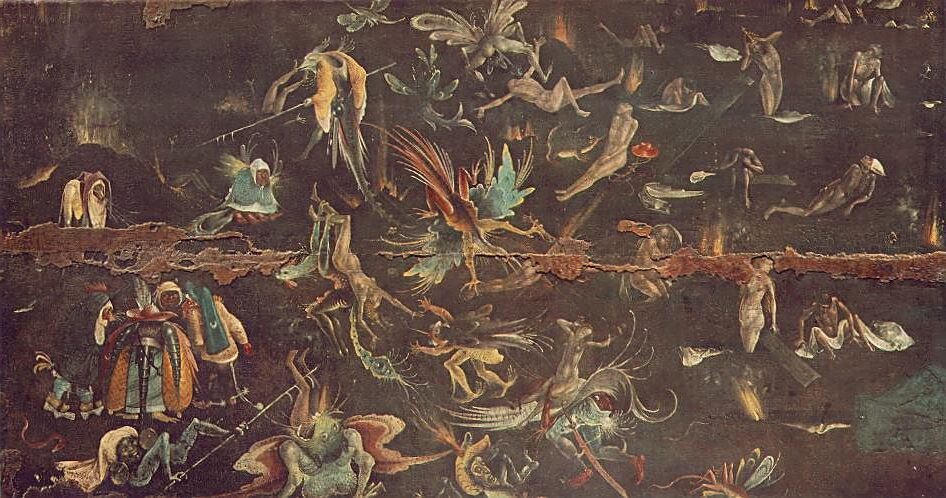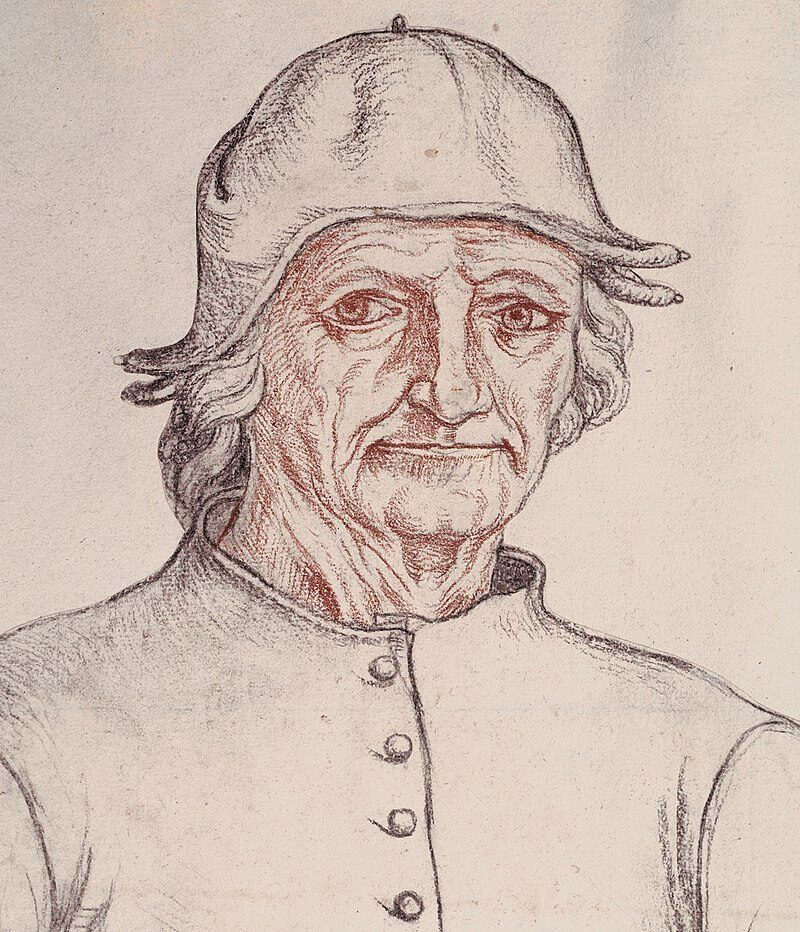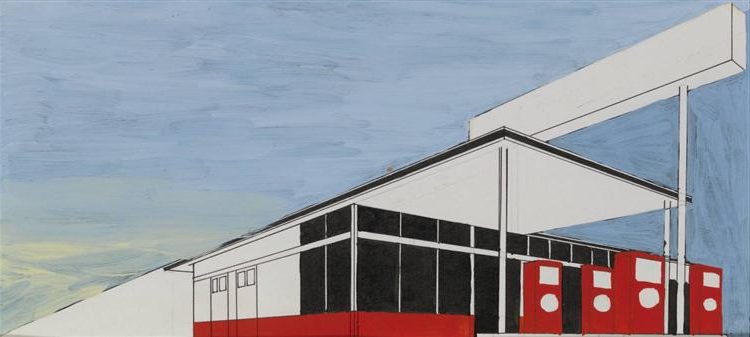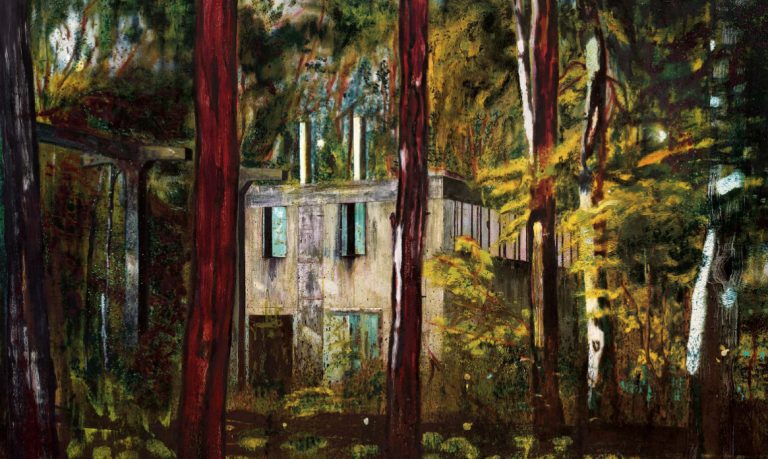Bosch Paintings: A Journey Through Surreal Imagery
Born: c. 1450, Duchy of Brabant, Burgundian Netherlands
Death: 9 August 1516, Duchy of Brabant, Habsburg Netherlands
Art Movement: Renaissance, Surrealism
Nationality: Dutch
Teacher: Anthonius van Aken (His Father)
Bosch Paintings: A Journey Through Surreal Imagery
Hieronymus Bosch and the Northern Renaissance
Hieronymus Bosch, also known as Jheronimus van Aken, was a Dutch painter whose work played a significant role in the Northern Renaissance. His art, full of religious symbolism and fantastical elements, set him apart as a leading figure in Early Netherlandish Painting within the Duchy of Brabant.
Biographical Overview
Born around 1450, Bosch spent most of his life in ‘s-Hertogenbosch, a city in present-day Netherlands. He hailed from a family of painters, ultimately shaping his career in the flourishing artistic climate of his hometown. Bosch’s marriage to a wealthy woman enabled him to pursue his artistic endeavors without financial worry.

Triptych of the Temptation of St. Anthony (c. 1501) by Hieronymus Bosch
His lifetime saw Europe undergoing significant cultural and religious shifts. The alignment of his personal beliefs with the broad social currents perhaps influenced his deeply religious and moralistic artwork. His paintings captured the moral struggles and vivid imagery essential to the spiritual climate of his time.
Artistic Influence and Style
Bosch is best known for his highly imaginative and allegorical works that often included bizarre and supernatural imagery. His paintings, such as “The Garden of Earthly Delights,” present complex narratives brimming with religious symbolism. These reflected the tensions and ideological transformations of the Northern Renaissance.
His unique use of symbolism influenced Early Netherlandish Painting by combining conventional religious themes with elements of fantasy and social critique. Bosch’s style has often been described as a precursor to Surrealism due to its dream-like quality. This combination of reality and fiction made his art both intriguing and mysterious, capturing the cultural richness of his time.
Notable Works and Critical Acclaim
Hieronymus Bosch’s paintings are celebrated for their detailed imagery and symbolic depth. Among his most renowned masterpieces are the intricate triptychs, “The Garden of Earthly Delights,” “The Last Judgment,” and “The Haywain Triptych,” each revered in art history for its unique narrative and artistic innovation.
The Garden of Earthly Delights
“The Garden of Earthly Delights” is one of Bosch’s most famous paintings. This large triptych is housed in the Prado Museum in Madrid. It presents a vivid depiction of paradise, earthly pleasures, and hell.
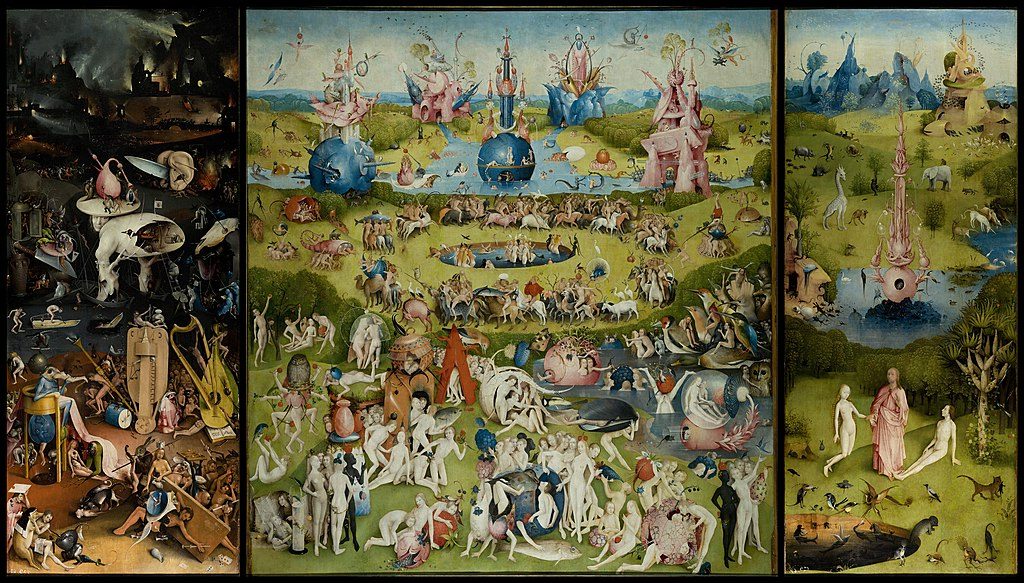
The Garden of Earthly Delights (c. 1495–1505) by Hieronymus Bosch
The left panel shows an idealized Garden of Eden with God, Adam, and Eve. The central panel progresses to a scene filled with people indulging in various pleasures. In contrast, the right panel illustrates a chilling vision of hell.
Bosch’s imaginative use of color and bizarre figures in this masterpiece has fascinated art enthusiasts and scholars, making it a subject of numerous interpretations and studies. Its detail and vivid imagery have kept viewers captivated through centuries.
The Last Judgment
Bosch’s “The Last Judgment” is another significant triptych, exploring themes of sin and salvation. This work, like “The Garden of Earthly Delights,” is rich with symbolic detail. It visualizes the final judgment of humanity, a common theme in religious art of that era.
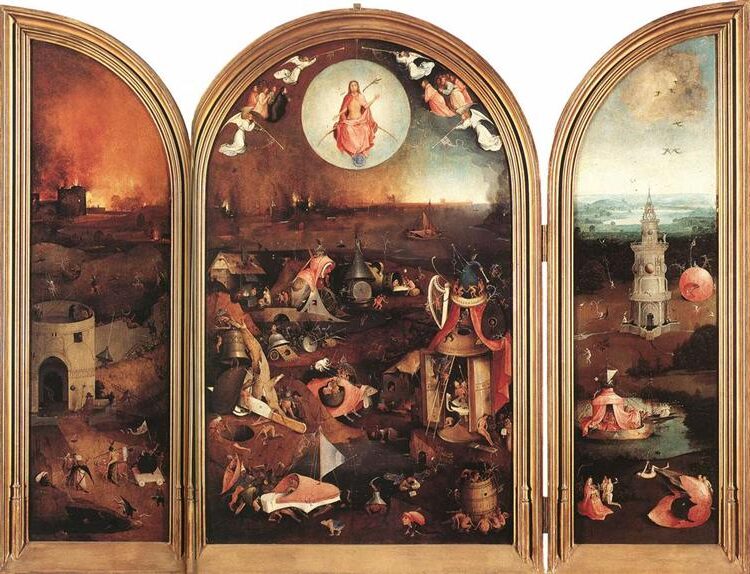
Last Judgment (1486) by Hieronymus Bosch
The first panel often shows the Garden of Eden, while the central panel displays the chaos of humanity succumbing to sin. The final panel depicts the torments of hell, articulated through disturbing yet mesmerizing imagery.
Considered a masterpiece of its time, this painting’s complex narrative and detailed depictions continue to attract critical acclaim and remain a focal point in art historical studies.
The Haywain Triptych
“The Haywain Triptych,” also exhibited at the Prado Museum, is celebrated for its moral narrative. This triptych illustrates the journey of a hay wagon through diverse scenes of life, culminating in hell.
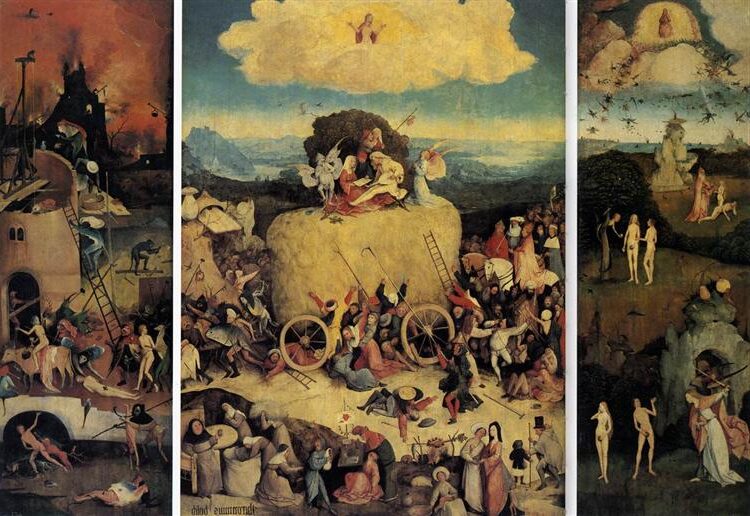
Haywain (c. 1500) by Hieronymus Bosch
In the first panel, Bosch presents idyllic scenes, while the central panel illustrates people seeking transient pleasures. The right panel returns to Bosch’s familiar theme of damnation.
This work is noted for Bosch’s unique technique, with meticulous brushwork that conveys his moral message. It remains a vital part of Bosch’s contribution to art, reflecting his view of human folly and spiritual themes.
Symbolism and Religious Themes
Hieronymus Bosch’s paintings are deeply layered with symbolism. His works often explore moral and religious concepts through detailed imagery. Bosch uses allegory to convey lessons on human nature and spirituality.
The Seven Deadly Sins and Allegorical Works
In Bosch’s paintings, the Seven Deadly Sins are a recurring theme. He uses allegorical works to personify these sins. Each sin is depicted with meticulous detail to show its impact on human behavior.

The Crucifixion of St. Wilgefortis (c. 1497) by Hieronymus Bosch
For instance, paintings might show people engaging in gluttony or sloth in exaggerated ways. This connects viewers to everyday struggles against these vices. Bosch uses dark humor and fantastical elements to highlight the moral choices humans face.
Allegory is a powerful tool in Bosch’s art. He often places figures in surreal settings where each element contributes to the narrative. These settings not only critique moral shortcomings but also pose questions about spiritual salvation. The use of allegorical imagery makes his work timeless and relevant across ages.
Biblical References and Saints
Bosch’s art is rich with Biblical references. Many paintings depict scenes from the Bible, allowing viewers to reflect on their faith. His artwork features saints who are central to Christian beliefs.
Saints are often portrayed with symbols identifying them, like St. John with a lamb or St. Peter holding keys. Such imagery provides insight into their virtues and roles.
Bosch didn’t shy away from illustrating events like the Passion of Christ. He captures the emotional depth of these stories through intricate details.
Bosch’s religious paintings often aimed to inspire personal reflection and devotion. Through these visual narratives, he links earthly life with spiritual teachings, inviting viewers to ponder their own spiritual journeys.
Bosch’s Contribution to Art and Legacy

Christ Before Pilate (c. 1520) by Hieronymus Bosch
Hieronymus Bosch’s work is a captivating exploration of human nature, fantasy, and morality. His unique visionary style inspired countless artists and movements across centuries.
Bosch Research and Conservation Project
The Bosch Research and Conservation Project is pivotal in understanding and preserving his paintings. This project employs advanced techniques to analyze Bosch’s work, revealing details about his methods and materials.
Through infrared imaging and pigment analysis, experts uncover hidden layers and intentions in his art. These findings help art historians grasp Bosch’s process, enhancing our appreciation of his intricate compositions.
Such scholarly efforts ensure Bosch’s masterpieces remain insightful study subjects for future generations, maintaining his enduring influence on the art world.
Influence on Later Artists and Movements
Bosch’s imaginative scenes, populated by fantastical creatures, laid the groundwork for later art movements. Renowned artists like Pieter Bruegel the Elder drew inspiration from Bosch’s vision, integrating similar themes into their work.
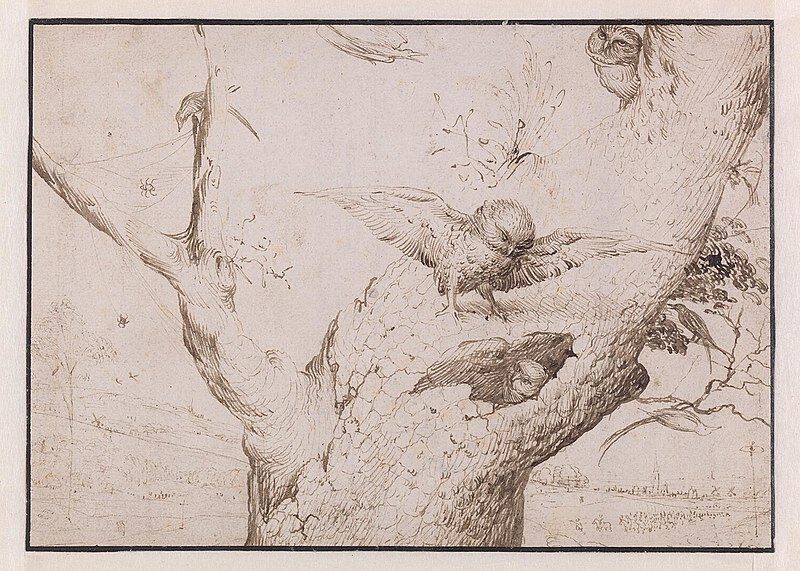
The Owl’s Nest by Hieronymus Bosch
Bosch’s dreamlike compositions foreshadowed Proto-Surrealism, influencing Surrealism that emerged in the 20th century. His ability to blend reality with the bizarre paved the way for artists to explore deeper psychological and abstract themes.
Bosch remains an important figure as both an Individualistic Painter and an Artistic Adviser to those exploring innovative, narrative-driven art forms.
Frequently Asked Questions
Hieronymus Bosch’s paintings are rich in symbolism, featuring unique themes influenced by various factors. Known for works like “The Garden of Earthly Delights,” his art remains impactful.
Where can Hieronymus Bosch paintings be found?
Bosch’s paintings can be found in several European museums. Notable locations include Museo del Prado in Madrid, which houses “The Garden of Earthly Delights,” and the Louvre in Paris. Other works are scattered across institutions in Germany and the Netherlands.
What themes and symbolism are present in Hieronymus Bosch’s artwork?
Bosch’s art is filled with religious themes, often depicting the struggle between good and evil. His paintings use fantastical imagery to illustrate moral lessons and cautionary tales. Symbolism, ranging from Biblical references to mythological creatures, plays a significant role in his work.
Can you list notable influences on Hieronymus Bosch’s art?
Bosch was influenced by religion, especially Catholicism, reflecting the societal norms of his time. His work also shows the impact of medieval folklore and early Northern Renaissance style. Additionally, his creative imagination contributed to the unique elements in his art.
What is the significance of ‘The Garden of Earthly Delights’?
“The Garden of Earthly Delights” is one of Bosch’s most famous triptychs. It explores human indulgence, paradise, and hell. The painting is known for its intricate detail, vivid imagery, and moral lessons, capturing the complexity of the human condition through surreal landscapes.
How many paintings did Hieronymus Bosch create?
While the exact number is uncertain, about 25 paintings are generally recognized as authentic works by Hieronymus Bosch. His surviving pieces include a combination of triptychs, altarpieces, and smaller panels.
Is there a collection of Bosch’s paintings in the United States?
No, there is no large collection of Bosch’s works in the United States. However, a few pieces attributed to Bosch or his workshop may occasionally appear in exhibitions at major art museums across the country.

